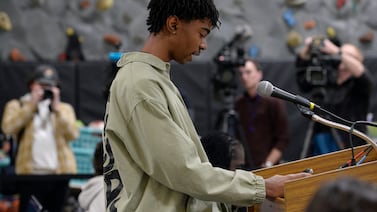Philadelphia students will get the chance to read about 14 prominent Black Philadelphians as Temple University’s Charles L. Blockson Afro-American Collection is giving the district 5,000 copies of “Black Lives Always Mattered!,” a graphic novel-style book it published with a grant from the Pew Center for Arts and Heritage.
Diane Turner, curator of the Blockson Collection, said getting the books into Philadelphia schools is a way of countering racial stereotypes and “sensationalism” about poverty and crime.
The donation comes as school boards, lawmakers, and parents across the country are working to ban teachers from mentioning race or discrimination, with some schools pulling books from library shelves and trying to ban critical race theory instruction. At least 36 states have adopted or introduced laws or policies restricting teaching about race or racism, according to a Chalkbeat analysis.
Six of the 10 most challenged books in an American Library Association survey of materials targeted in 2020 touch on racial issues, with complaints including “racial slurs”(“To Kill a Mockingbird,” “Of Mice and Men”) and “divisive language” (“Something Happened in Our Town: A Child’s Story About Racial Injustice).” “The Hate U Give,” a story of a girl whose best friend was fatally shot by a police officer, was challenged for profanity and an “anti-police message.”
Laws and regulations are being pushed across the country. A Texas law that took effect in December 2021 says teachers who discuss widely debated issues must do so “free from political bias” and bans lessons that might make individuals feel “blame or guilt for actions committed by other members of the same race or sex.” Governor Greg Abbott has also promoted a “parental bill of rights” that would require instructional materials to be posted online at the beginning of a semester.
And in Tennessee, a county school board pulled “Maus,” a Pulitzer Prize-winning graphic novel using cats and mice as stand-ins for Nazis and Jews during the Holocaust, citing “unnecessary use of profanity and nudity” and “depiction of violence and suicide.”
That’s not happening in Philadelphia, said Ismael Jimenez, social studies curriculum specialist for the School District of Philadelphia. “In Philadelphia, we kind of are isolated in our bubble, where we’re able to take ‘Black Lives Always Mattered!’ and distribute it in schools,” he said. “We haven’t heard or received any backlash.”
But in other parts of the state, there is talk of limiting teaching about race. Republican lawmakers have introduced a bill that would restrict the teaching of “racist and sexist concepts” in Pennsylvania public schools and universities.
Turner hopes the book will encourage students and others to visit the Blockson Collection — admission is free — and learn more about the individuals featured in the book and other notable African-Americans. The public can read or purchase “Black Lives Always Mattered!” there, she said. Jiminez said there will be one copy for each school in the district, and African-American history teachers will receive extra copies for their classes. There will also be an opportunity for teacher training on how to teach graphic novels, a “transferable skill,” he said.
The plan is to focus on schools in North Central Philadelphia. “Most schools in and around the Temple neighborhood are comprehensive high schools,” Jimenez said. “It’s very important for us to really center our energy on those areas usually neglected for the Mastermans and Centrals,” he said.
The Blockson Collection put together a team of artists to illustrate the stories of notable 20th-century Philadelphians, Turner said. “We felt it was important for all students to be able to see themselves in the curriculum, because that’s what motivates them,” she said. “We also wanted to promote literacy, and the graphic novel is something young people like.”
The book features well-known figures such as author and sociologist W.E.B. Du Bois and singer Marian Anderson, in addition to some less famous Philadelphians like architect Julian Abele, who helped design the Philadelphia Museum of Art.
“Everybody runs to the Rocky statue,” Turner said. “To the left of that, there’s a state historical marker which nobody really notices” commemorating Abele’s efforts, she said.
The book also features religious leaders Rev. Leon Sullivan, founder of the first Black-owned shopping center in the United States – Progress Plaza — and community activist Father Paul Washington, who held the first Black Power conference, Turner said. Christopher Perry, founder of The Philadelphia Tribune, and photographer John W. Mosley, who documented the lives of Black Philadelphians, are also featured.
Cecil B. Moore is a name neighborhood students know, but that’s likely because of the boulevard named after him, Turner said. “A lot of students don’t know who he is,” and the book will “give them the opportunity to know” about the life of the lawyer and activist, she said.





